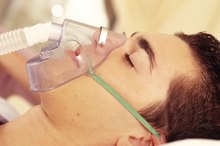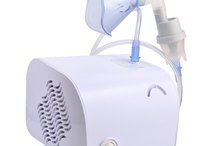How to Reduce Whistling of CPAP
While most CPAP machines and masks make a little noise, an obvious whistling noise can ruin your sleep, and your partner's. Whistling is most often caused by air escaping through the exhalation vents on or near the mask. Fortunately, it's an easy problem to fix.
How to Stop CPAP Whistling
Find the exhalation vents on your mask. These are small holes that relieve the pressure in the mask when you exhale. If you use a mask that cups your nose, the vents are probably on the cup itself. If you have a mask that uses individual nasal puffs, the vent holes will be on the tubes leading up to the puffs.
How to Wear a Nasal Cannula Comfortably
Learn More
Install diffusers if they were supplied with your mask. Diffusers are foam pads or rings that go over the vents on your mask. Check your supplies to see if diffusers were shipped with your mask, and install them according to directions. If you didn't receive diffusers, go on to the next step.
Cut a length of cloth tape to cover the vents.
How to Assemble a Blood Pressure Cuff
Learn More
Apply the cloth tape over the vent holes on the mask, or around the tubing if the vent holes are located there. Be careful the tape does not cover other mask components, such as straps, nasal cushions, etc.
Put on your mask and start up the CPAP machine. Check that the whistling noise is gone, and that you can still exhale easily through the mask. If exhalation is difficult, try a more porous tape, such as a gauze tape.
Tips
After you've used the diffuser or cloth tape for a while, you'll notice a dark spot form over the vent holes. This is from air impurities being filtered out of the vented air. Diffusers can normally be washed in warm soapy water; cloth tape should be replaced once it gets dirty. If this procedure does not stop the whistling, your nasal cushion or tubing might be leaking. If this is the case, you'll normally need to replace the whistling part.
Warnings
Do not keep the tape on your mask if you're finding it difficult to exhale. This can cause inner ear pressure to build up, or can even cause a harmful buildup of carbon dioxide in the mask. Remove the tape and use a more porous type.
- Find the exhalation vents on your mask.
- If you use a mask that cups your nose, the vents are probably on the cup itself.
Related Articles
References
- SleepGuide: CPAP whistle?
- American Sleep Apnea Association. Mask types.
- Alqahtani JS, AlAhmari MD. Evidence based synthesis for prevention of noninvasive ventilation related facial pressure ulcers. Saudi Med J. 2018;39(5):443–452. doi:10.15537/smj.2018.5.22058
- Rowland S, Aiyappan V, Hennessy C, et al. Comparing the efficacy, mask leak, patient adherence, and patient preference of three different CPAP interfaces to treat moderate-severe obstructive sleep apnea. J Clin Sleep Med. 2018;14(1):101–108. doi:10.5664/jcsm.6892
Tips
- After you've used the diffuser or cloth tape for a while, you'll notice a dark spot form over the vent holes. This is from air impurities being filtered out of the vented air. Diffusers can normally be washed in warm soapy water; cloth tape should be replaced once it gets dirty.
- If this procedure does not stop the whistling, your nasal cushion or tubing might be leaking. If this is the case, you'll normally need to replace the whistling part.
Warnings
- Do not keep the tape on your mask if you're finding it difficult to exhale. This can cause inner ear pressure to build up, or can even cause a harmful buildup of carbon dioxide in the mask. Remove the tape and use a more porous type.
Writer Bio
Scott Knickelbine began writing professionally in 1977. He is the author of 34 books and his work has appeared in hundreds of publications, including "The New York Times," "The Milwaukee Sentinel," "Architecture" and "Video Times." He has written in the fields of education, health, electronics, architecture and construction. Knickelbine received a Bachelor of Arts cum laude in journalism from the University of Minnesota.









